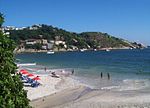Grumari

Grumari is a neighborhood in the West Zone of Rio de Janeiro, Brazil. Grumari is a municipal park and is the city's only neighborhood with no residents. Grumari has beaches that have not changed in hundreds of years. Salt marsh vegetation grows next to the beach and a rain forest surrounds its hills. A nude beach is next to Grumari beach called Abricó beach (Portuguese for Apricot beach). It is the only nude beach around the city. Five virgin beaches with pristine vegetation are in this neighborhood: Inferno Beach (Hell's beach), Funda beach (Deep Beach), Búzios beach (Whelks beach), Meio's beach (middle's beach) and Perigoso beach (dangerous beach). The word Grumari comes from ancient South American dialects. the word refers to the tip of a mammal's nipples. In the same way, the beach sticks out onto the ocean, "feeding" the fish.
Excerpt from the Wikipedia article Grumari (License: CC BY-SA 3.0, Authors, Images).Grumari
Trilha do Morro do Grumari, Rio de Janeiro Grumari
Geographical coordinates (GPS) Address Nearby Places Show on map
Geographical coordinates (GPS)
| Latitude | Longitude |
|---|---|
| N -23.053333333333 ° | E -43.535 ° |
Address
Trilha do Morro do Grumari
Trilha do Morro do Grumari
23020-340 Rio de Janeiro, Grumari
Rio de Janeiro, Brazil
Open on Google Maps






